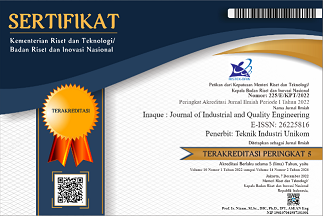PERENCANAAN KEBUTUHAN MATERIAL MENGGUNAKAN METODE LOT-SIZING DENGAN PENERAPAN METODE FORECASTING TIME SERIES DALAM PERENCANAAN PRODUKSI DI KONVEKSI XYZ
DOI:
https://doi.org/10.34010/iqe.v10i1.6559Abstract
XYZ convection is an industry that is engaged in the production as well as marketing or selling robes. This business was founded in 2012 in Sambas Regency, West Kalimantan. Based on historical data obtained, the demand for robes at XYZ Convection has fluctuated erratically, causing companies to sometimes produce in excess quantities and produce in insufficient quantities, resulting in non-optimal sales activities. The purpose of this research is to optimize the production plan to meet future demand. The stages in this research are data collection, plotting data, forecasting using the time series method, conducting validation tests on the selected method, making RRP, doing aggregate planning, making master production schedule, making RCCP and planning material requirements using 4 lot methods. sizing methods, namely the LFL, EOQ, POQ and FPR methods. The results showed that the best method was the centered moving average method, because it had the smallest MSE value of 4050.13, the smallest MAD was 47.11 and the smallest MAPE was 11.06%. The total cost required for the production of robes for 12 periods is IDR 319,120,000.00. While the planning of raw material requirements used the LFL method and the POQ method, with the total cost of the raw material for the robes needed for the next 12 periods, which is Rp. 428,884,300. The cost for each raw material is Rp. 456,460,000 for fabric, Rp. 10,448,000 for zippers, 1,036,000 for buttons, Rp 1,840,000 for vislin, sewing thread for Rp. 7,836,000 and thread sale of Rp. 5,224,000. . So the impact of this research is, it can minimize the cost of raw material needs.
Downloads
Published
Issue
Section
License
Authors who publish this journal agree to the following terms:
The author holds the copyright and grants the right of the first publication journal to enable INAQUE to share the work with acknowledgment of the author's work and early publications in this journal.
Authors may include separate additional contractual arrangements for the non-exclusive distribution of the journal's published version (for example, submit to an institutional repository or publish in a book), with the acknowledgment of its initial publication in this journal
Authors are permitted and encouraged to post their work online before and during the delivery process, as it may lead to productive exchanges, as well as quotations of previously published and longer works








